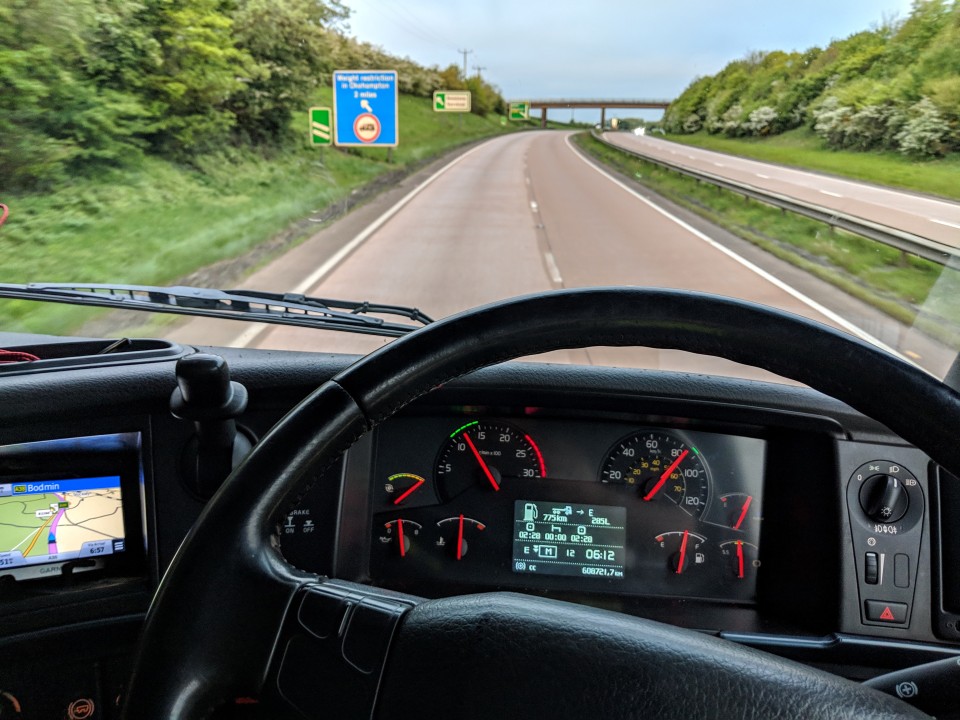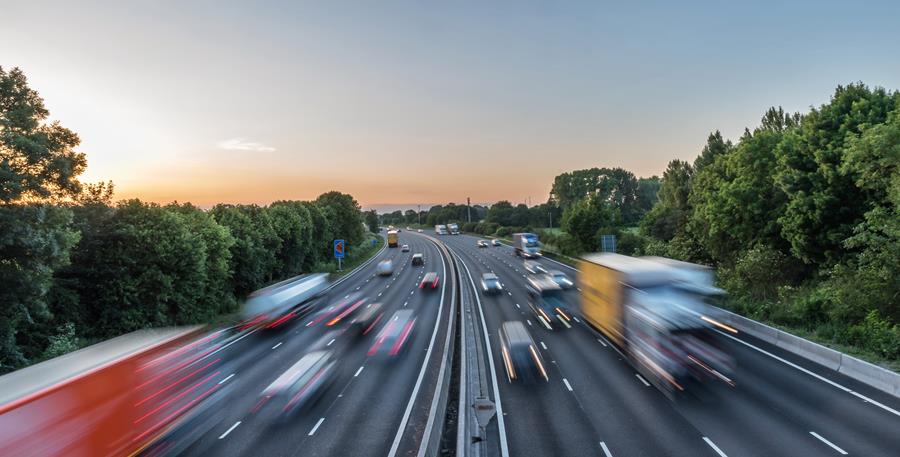
Susie Jones
Tachograafregels gemakkelijk gemaakt
Gemaakt: 01-08-2024
•
Bijgewerkt: 08-08-2024
De wereld van de tachograafregels kan verwarrend zijn voor de meest ervaren vrachtwagenchauffeur. Laat staan voor iemand die nieuw is in de sector. Wij proberen wat van die verwarring weg te nemen.
Wat is een tachograaf en waarom hebben we ze?
Volgens het woordenboek is een tachograaf "een apparaat dat in voertuigen zoals vrachtwagens en bussen wordt geplaatst om informatie te registreren zoals hoe snel het voertuig gaat, hoe ver het rijdt en het aantal pauzes dat de chauffeur neemt".
Het doel van een tachograaf is om vermoeidheid bij chauffeurs te voorkomen en ervoor te zorgen dat chauffeurs en werkgevers zich aan de regels houden. De liefdadigheidsinstelling voor verkeersveiligheid Brake meldt dat "bij vier op de tien aan vermoeidheid gerelateerde ongevallen iemand betrokken is die een bedrijfsvoertuig bestuurt". Daarom spelen de regels voor tachografen een cruciale rol bij het terugdringen van dit aantal.
Wanneer heb je een tachograaf nodig?
Je hebt een tachograaf nodig als je bruto voertuiggewicht hoger is dan drieënhalve ton. Het is belangrijk om te onthouden dat dit ook geldt voor het trekken van een aanhangwagen. Er zijn een paar uitzonderingen op deze regel:
Als je alleen op de openbare weg rijdt
Als het voertuig wordt bestuurd door strijdkrachten, politie of brandweer
Als je een commercieel wagenpark hebt en voertuigen met een maximumgewicht van zeveneneenhalve ton gebruikt, en je reis minder dan 100 km van je uitvalsbasis is.
Als je goederen vervoert en je voertuig elektrisch is
Als je apparatuur of machines vervoert voor gebruik door de bestuurder en het besturen van dit voertuig niet je hoofdtaak is.
Wat zijn de verschillende soorten tachografen?
Er zijn drie verschillende soorten tachografen:
Analoog: Deze werden in 1986 verplicht in Europa. Analoge tachografen gebruiken vellen waspapier om de gegevens van de bestuurder te registreren. Chauffeurs voeren de gegevens handmatig in en voeren ze in een tachograaf in.
Digitaal: Deze werden in 2006 geïntroduceerd. Ze worden gebruikt door meer dan een miljoen transportbedrijven en meer dan zes miljoen professionele chauffeurs. Digitale tachografen registreren chauffeursgegevens op een intern opslagapparaat en een chauffeurskaart.
Slim: Vanaf juni 2019 verplichtte de Europese Unie bedrijven om slimme tachografen te gebruiken. Deze registreren automatisch de locatie van het voertuig aan het begin en het einde van elke rit. Ze geven ook elke drie uur updates
Wat betekent elk tachograafsymbool?
Bekijk onze video waarin elk tachograafsymbool wordt uitgelegd
Breekregels
Voor de veiligheid van de vrachtwagenchauffeur en iedereen op de weg moeten de verkeersregels worden nageleefd. We hebben de belangrijkste punten opgesomd.
Rijtijd:
- Mag niet langer zijn dan vierenhalf uur voor een pauze.
Pauzes:
- Moet minstens 45 minuten duren, tenzij een bestuurder een rustperiode neemt
Rusttijd:
- Tijdens een rustperiode mag er niet worden gereden of ander werk worden uitgevoerd.
Pauzes splitsen:
Een volledige pauze van 45 minuten kan worden opgesplitst door een pauze van 15 minuten gevolgd door een pauze van 30 minuten.
Pauzes moeten worden verdeeld over de vier en een half uur rijtijd
Volgens de EU-regels moet, als de pauzes worden opgesplitst, de tweede pauze minstens 30 minuten duren.

Dagelijkse rijbeperking
De dagelijkse rijbeperking verwijst naar de maximale rijtijd op een dag. Negen uur is het maximum, maar dit kan verhoogd worden naar 10 uur. Dit kan echter niet meer dan twee keer in een vaste week. Dagelijkse rijtijd kan worden gedefinieerd als:
De totale bij elkaar opgetelde rijtijd tussen het einde van een dagelijkse rusttijd en het begin van de volgende dagelijkse rusttijd
De totale bij elkaar opgetelde rijtijd tussen een dagelijkse rusttijd en een wekelijkse rusttijd. .
Wekelijkse en tweewekelijkse rijlimiet
Bestuurders moeten ervoor zorgen dat ze de maximale wekelijkse en tweewekelijkse rijlimieten niet overschrijden.
De maximale wekelijkse rijtijd is 56 uur (geldt voor een vaste week)
Een vaste week begint om 00.00 uur en eindigt de volgende zondag om 24.00 uur.
Een tweewekelijkse rijbeperking is 90 uur.
Dagelijkse rust
Daarnaast moet er dagelijks rust worden genomen.
Chauffeur moet 11 uur aaneengesloten rust nemen. Dit kan worden teruggebracht tot negen
Deze vermindering kan maximaal drie keer plaatsvinden tussen wekelijkse rustperioden
De rustperiode moet binnen 24 uur na het einde van de laatste dagelijkse of wekelijkse rustperiode worden voltooid.
Dagelijkse rust kan in het voertuig worden genomen, maar er zijn geschikte slaapfaciliteiten nodig. Als deze faciliteiten ontbreken, moet de chauffeur accommodatie zoeken. Kijk op onze locaties pagina om te zien welke truckstops deze service aanbieden.
Wekelijkse rusttijd
Wekelijkse rustperioden moeten niet later genomen worden dan aan het einde van zes opeenvolgende perioden van 24 uur vanaf het einde van de laatste wekelijkse rust.
Bestuurders moeten minstens 45 uur rust nemen
Ze kunnen een beperkte wekelijkse rusttijd van ten minste 24 uur nemen
Verminderde wekelijkse rust moet worden gecompenseerd in één blok, en minstens negen uur voor het einde van de derde week.
Hoewel verminderde rust kan worden genomen, is het de moeite waard om op te merken dat in twee opeenvolgende weken waarin verminderde rust is genomen, er één 45 uur lang moet zijn.
(https://prodsnapstorage.blob.core.windows.net/public-news/a9b3146d-f5ac-4e18-89f8-519f429c6163-marcin-jozwiak-kGoPcmpPT7c-unsplash.jpg)
Meervoudige bemanning
Sommige chauffeurs kunnen een andere chauffeur aan boord nemen. De voordelen zijn onder andere een hogere productiviteit, meer afgelegde kilometers en een langere rijtijd.
Beide bestuurders moeten dagelijks negen uur rust nemen
Deze dagelijkse rust moet worden genomen binnen 30 uur in plaats van 24 uur.
Het eerste uur van multi-manning is er geen andere bestuurder nodig. Na een uur wordt het verplicht.
Overtochten per veerboot of treinreizen
Zoals hierboven vermeld moet de normale dagelijkse rusttijd van een bestuurder 11 aaneengesloten uren bedragen, er zijn echter enkele uitzonderingen op deze regel. Op voorwaarde dat het voertuig wordt begeleid door de bestuurder; de dagelijkse rusttijd mag twee keer worden onderbroken, maar mag in totaal niet langer zijn dan één uur. Bijvoorbeeld in- en uitstappen voor veerboten en treinen.
Als de normale dagelijkse rusttijd op deze manier wordt onderbroken, moet de totale rusttijd ten minste 11 uur bedragen of 12 uur indien opgesplitst.
Wat is de één-minuut-tachograafregel?
De één-minuutregel werd van kracht in oktober 2011. Deze verwijst naar oudere wetgeving die bepaalde dat een minuut met ten minste vijf seconden rijden als rijtijd moest worden geregistreerd. De EU heeft deze wetgeving echter gewijzigd, zodat de langste ononderbroken activiteit binnen een minuut als die specifieke activiteit wordt geregistreerd.
Wat gebeurt er als ik de tachograafregels niet naleef?
Het niet naleven van de tachograafregels kan boetes en soms gevangenisstraf tot gevolg hebben. Over het algemeen hangt de straf af van de ernst van de overtreding. De meeste overtredingen van de tachograaf worden bestraft met een vaste boete. Chauffeurs hebben tot 28 dagen de tijd om vaste boetes te overwegen.
Er zijn twee soorten boetes en straffen in het Verenigd Koninkrijk.
Boete van niveau vier: Hiervoor geldt een maximum van £ 2.500; dit maximum geldt voor elke tacho-boete. Bij meerdere overtredingen van niveau vier kan echter een maximumboete per overtreding worden opgelegd.
Boete van niveau vijf: Deze is begrensd tot 5.000 pond, maar net als bij boetes van niveau vier kan bij meerdere overtredingen de maximale boete worden opgelegd.
De regels van de tachograaf kunnen moeilijk te begrijpen zijn. Ze niet naleven kan echter leiden tot veiligheidsproblemen en mogelijke boetes. Door de regels te begrijpen en op te volgen, kunnen wagenparken en chauffeurs hun voertuigen veilig en legaal inzetten. Het is belangrijk om te weten dat de regels en voorschriften voor tachografen per land kunnen verschillen.



